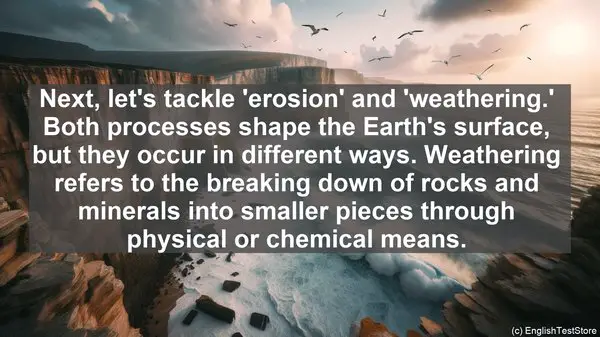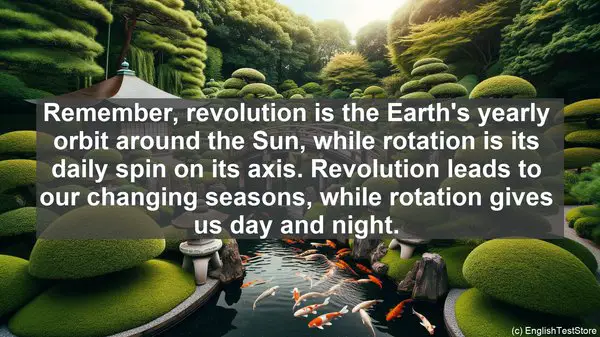Introduction
Today, we’re going to dive into the fascinating world of Earth Science. As you explore this subject, you may come across some words that seem similar but have distinct meanings. These words can be confusing, but fear not! In this lesson, we’ll clarify the top 10 commonly confused words in Earth Science.
1. Weather vs. Climate
The first pair of words that often causes confusion is ‘weather’ and ‘climate.’ While they both deal with atmospheric conditions, they differ in their scope. Weather refers to short-term conditions, such as temperature and precipitation, in a specific area. On the other hand, climate describes long-term patterns of weather in a region. So, while you can expect a rainy day (weather) in a tropical rainforest, the overall climate of that region is characterized by high precipitation.
2. Erosion vs. Weathering
Next, let’s tackle ‘erosion’ and ‘weathering.’ Both processes shape the Earth’s surface, but they occur in different ways. Weathering refers to the breaking down of rocks and minerals into smaller pieces through physical or chemical means. Erosion, on the other hand, involves the transport of these weathered materials by wind, water, or ice. In simpler terms, weathering is the ‘breaking’ while erosion is the ‘carrying away.’
3. Latitude vs. Longitude
Moving on to geography, we have ‘latitude’ and ‘longitude.’ These lines help us pinpoint locations on the Earth’s surface. Latitude lines run parallel to the equator and measure the distance north or south of it. In contrast, longitude lines, also known as meridians, run from pole to pole and measure the distance east or west of the Prime Meridian. So, if you’re giving someone directions, you’ll need both latitude and longitude coordinates.

4. Renewable vs. Non-Renewable
When discussing energy sources, it’s crucial to understand the difference between ‘renewable’ and ‘non-renewable.’ Renewable resources, like solar and wind energy, can be replenished naturally over time. Non-renewable resources, such as fossil fuels, are finite and take millions of years to form. As we strive for sustainable practices, the focus is on utilizing more renewable sources to reduce our dependence on non-renewable ones.
5. Weathering vs. Erosion
Wait, didn’t we cover this already? Yes, but it’s a common mix-up. Remember, weathering is the breakdown of rocks, while erosion is the transportation of those weathered materials. Think of it as weathering being the ‘preparation’ stage, and erosion being the ‘movement’ stage.
6. Evaporation vs. Condensation
Now, let’s delve into the water cycle. ‘Evaporation’ and ‘condensation’ are two vital steps in this process. Evaporation occurs when water changes from a liquid to a gas, usually due to heat. Condensation, on the other hand, is the opposite. It’s when water vapor cools and changes back into a liquid, forming clouds. So, the next time you see a cloud, remember it’s a result of condensation.
7. Revolution vs. Rotation
When it comes to celestial movements, ‘revolution’ and ‘rotation’ are often confused. Revolution refers to the Earth’s yearly orbit around the Sun, which takes approximately 365 days. On the other hand, rotation is the Earth’s daily spin on its axis, completing one full rotation in about 24 hours. So, while rotation gives us day and night, revolution is responsible for our changing seasons.
8. Igneous vs. Sedimentary
In geology, we encounter various rock types. Two of the most common ones are ‘igneous’ and ‘sedimentary.’ Igneous rocks form from the cooling and solidification of molten material, such as lava or magma. Sedimentary rocks, on the other hand, are created through the accumulation and compaction of sediments over time. So, if you find a rock with visible layers, chances are it’s sedimentary.
9. Revolution vs. Rotation
Wait, didn’t we cover this already? Yes, but it’s a common mix-up. Remember, revolution is the Earth’s yearly orbit around the Sun, while rotation is its daily spin on its axis. Revolution leads to our changing seasons, while rotation gives us day and night.
10. Volcano vs. Earthquake
Our final pair of words, ‘volcano’ and ‘earthquake,’ both involve the Earth’s dynamic nature. A volcano is a vent in the Earth’s crust through which molten rock, ash, and gases are ejected. It’s essentially a mountain that forms from volcanic activity. On the other hand, an earthquake is a sudden release of energy in the Earth’s crust, resulting in shaking. So, while a volcano is associated with eruptions, an earthquake is characterized by ground movement.

